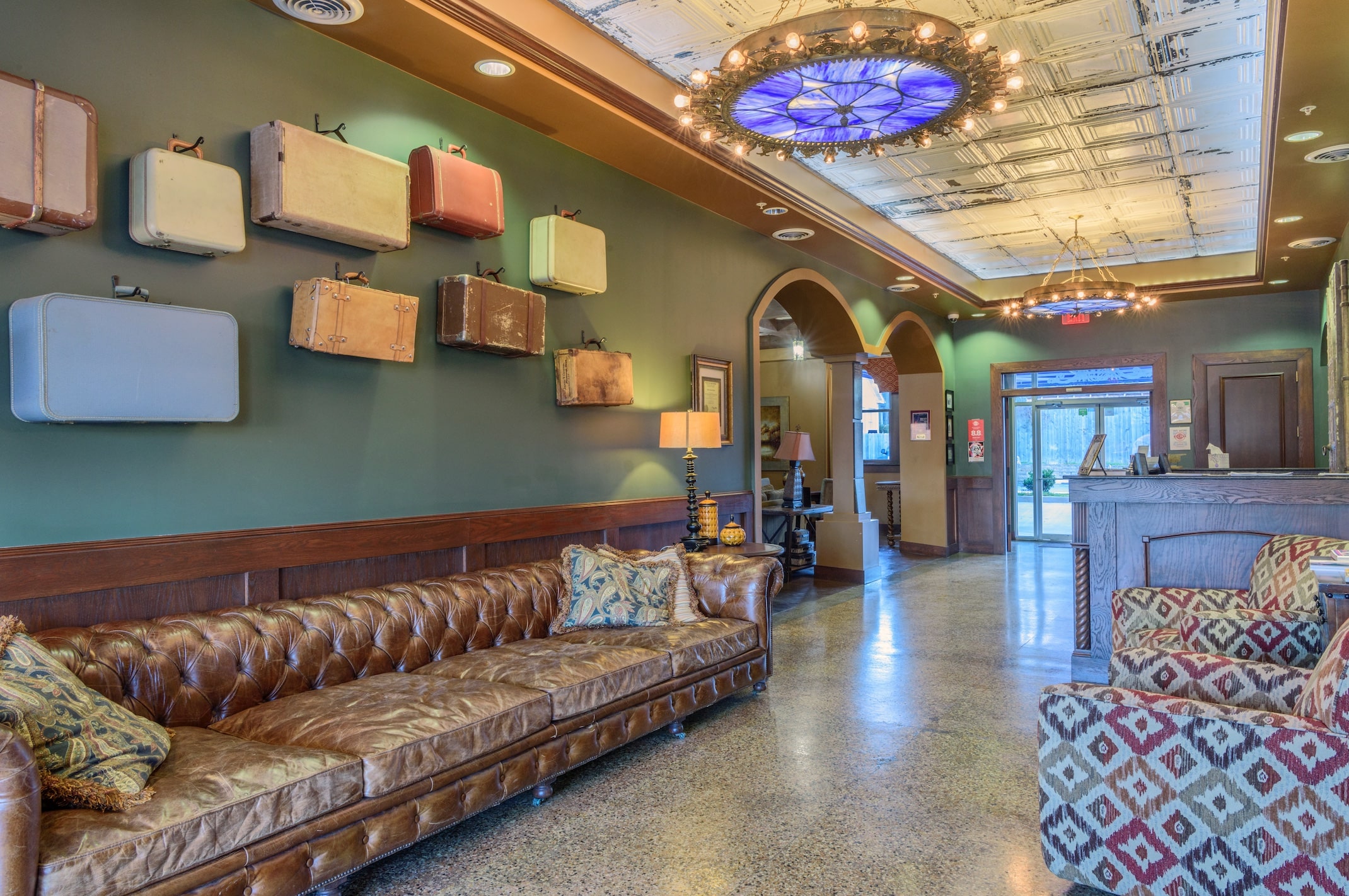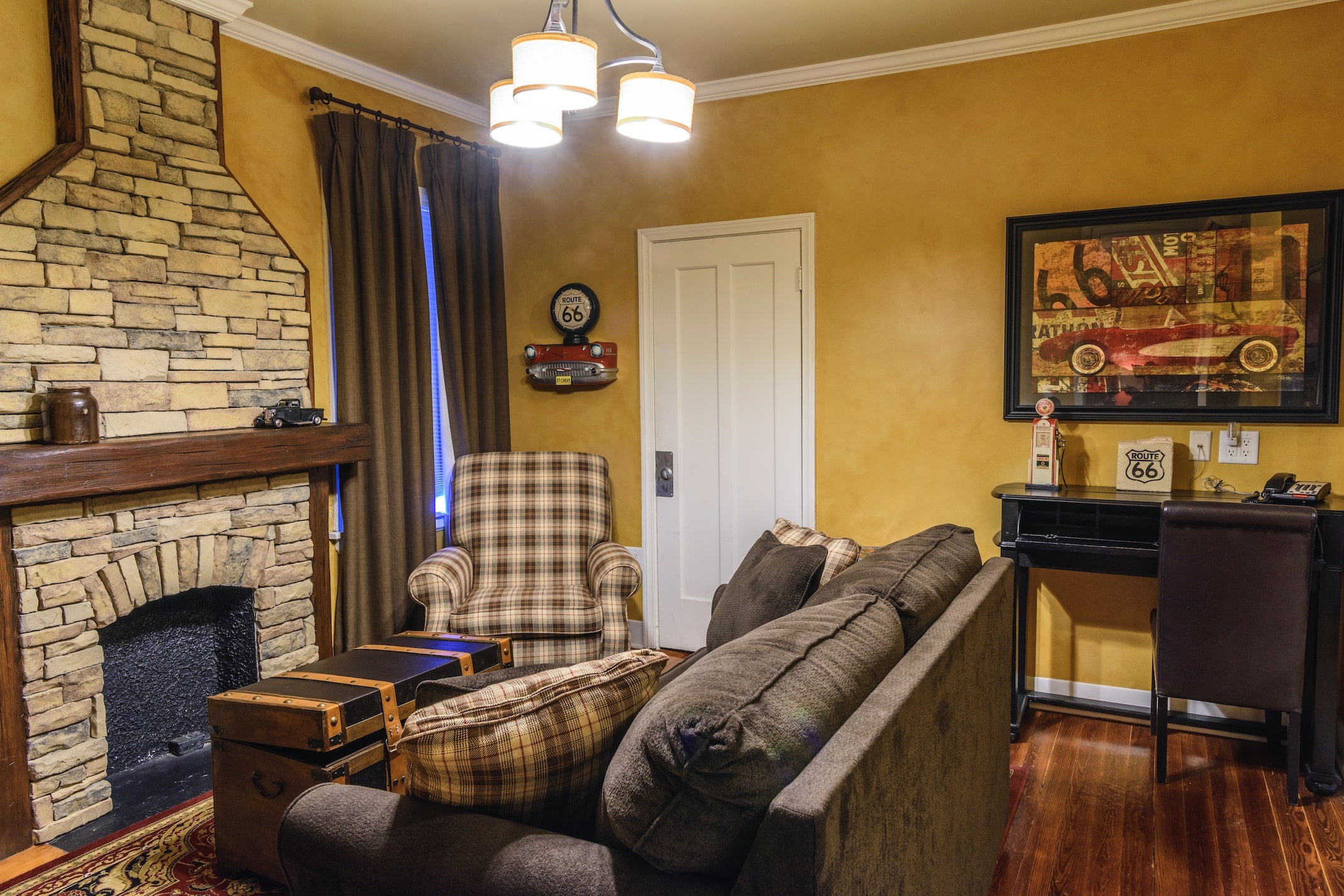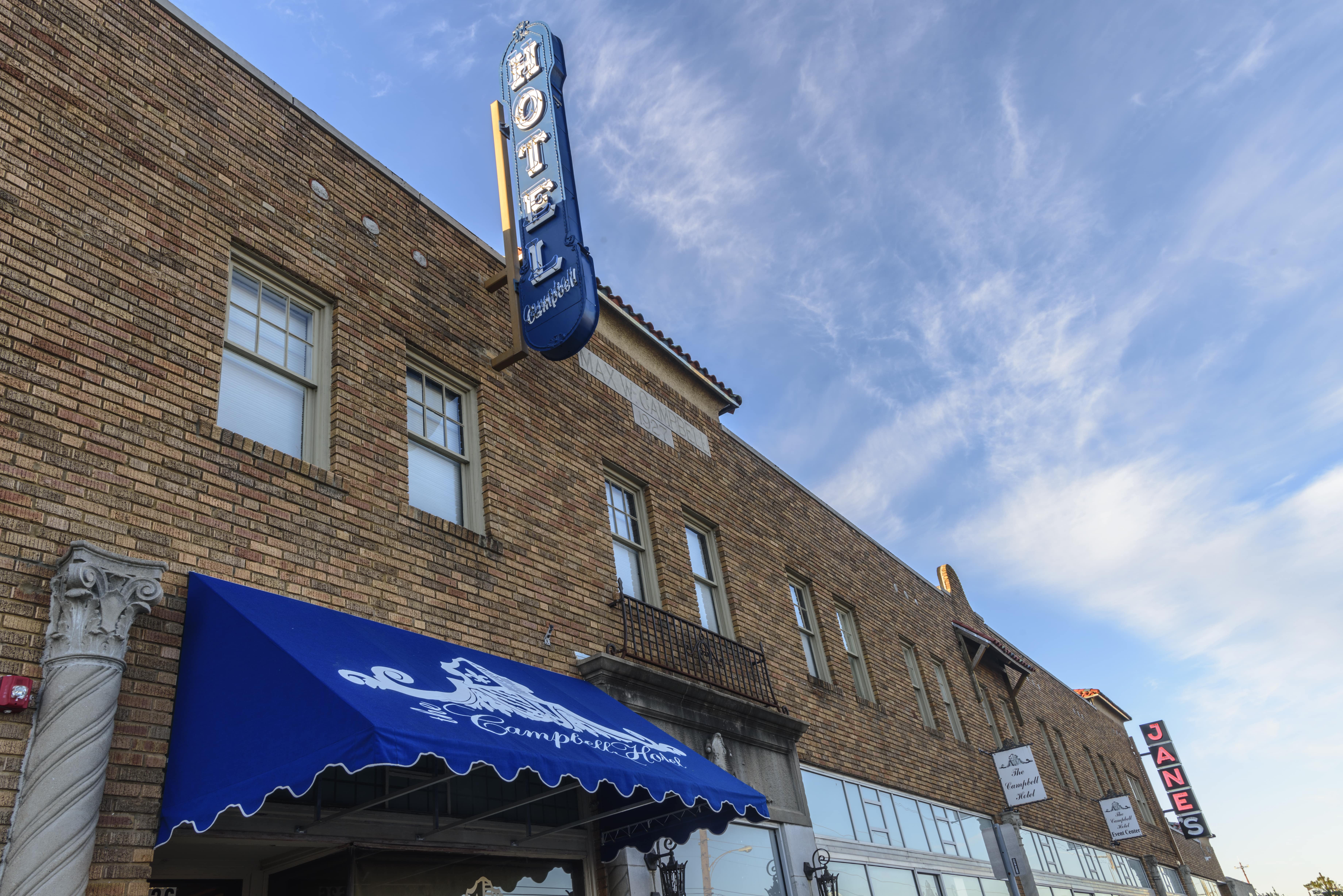End of the Line
The Campbell Building was erected at what was then the end of a trolley car line running east and west along 11th Street from downtown to Delaware Street. Upstairs was the Casa Loma Hotel, while on the street level were various retail tenants, including a barbershop, beauty shop, the Campbell Drug Store, and a Safeway grocery. The trolley car shuttled businesspeople and well-heeled tourists from what was once the edge of town, to the Central Business District.
“The Campbell Hotel was built in 1927,” Meek said. “It was built by a fellow named Max Campbell, who was a banker and a developer. He modeled it after a hotel he had seen in Kansas City. Tulsa was the oil capital of the world for many years, and the heyday of the hotel was in the 1950s and 1960s.”
Originally, Route 66 didn’t follow 11th Street directly to downtown. Instead, it jogged north at Mingo, and then west on Admiral. In 1932, the route was straightened, and suddenly the Casa Loma found itself curbside to the Mother Road.
“There used to be a rail trolley that ran along 11th,” Meek recalled. “This hotel basically served the businessmen, so you could come to the Casa Loma and stay there for four bits a night. The hotel was basically a businessman’s hotel.”
Designed with extended stay visitors in mind, the Casa Loma had 32 rooms when built, and as was common in hotels of that era, offered shared bathroom facilities. Architecturally, it reflects the Mission Spanish Colonial Revival period style popular at the time, even if it wasn’t an exact fit for the rather Midwest Tulsa landscape.
However, progress was not kind to Route 66 and East 11th. I-44 was built as a bypass loop around the south and east sides of town in the 1950s, while I-244, which closely approximated Route 66, was built in two stages in 1967 and 1975. Route 66 through town was demoted to Business 66 status in 1959, signaling to motorists that it was no longer the main thoroughfare through Tulsa.
The oil bust of 1982-1984 further added to Tulsa’s woes, with countless jobs lost and companies going belly-up. The combination of traffic being diverted along freeways and a tanking economy left East 11th to fend for itself, which it did not do well. The entirety of the strip fell into disrepair.
By the late-1990s, the Campbell stood vacant and in decay, like much of East 11th. It was deemed beyond repair by developers, and some whispered of demolition. The freeway had long supplanted 11th Street as a major cross-country thoroughfare for travelers, and what progress hadn’t taken away, an economically challenged neighborhood helped along. Even first-generation Route 66 nostalgics plying the Mother Road were reluctant to stop for long.
That all began to change in 2008 when Aaron Meek and Barbara Casey purchased the building and began renovations. Meek is now the sole owner and saw a future in the Campbell Building as well as East 11th Street. Naysayers said it couldn’t, even shouldn’t be done given the blight of the streetscape. Route 66 was where Meek was raised, so he had a special affinity for the neighborhood. “I was pretty much raised a few doors off 11th Street at Peoria. Those were my old stomping grounds. I grew up in the era of Route 66. It’s just what you feel comfortable with,” he said, explaining his motivations.
Meek soldiered on, undaunted by local skepticism, and the hotel was reopened in 2011 as the Campbell, honoring its building namesake developer. The second floor was gutted, plumbing was retrofitted, and rooms reconfigured. There are now 26 rooms, each with private baths. Down below at street side, a restaurant and bicycle shop are now in operation. The building is also on the National Registry of Historic Places, recognized for its significance on the Tulsa scene.
“Because it is a historic hotel, the flooring is original, and we have a lot of the older tubs still here,” said Diane Morrison, General Manager of the hotel. “Visitors like the quaintness of it. Each one of the rooms is individually designed so there are no two rooms alike; every room has a lot of personality,” Theme rooms run the gamut, from the Leon Russell Room to the Route 66 Suite, the Oil Baron’s Suite, and the Tulsa Art Deco Room.
“I like old buildings,” Meek explained. “They present a great challenge, and there’s a lot of satisfaction when you get them done. The hotel was originally going to be retail on the first floor, and the second floor was going to be loft apartments. And then I thought, ‘Oh, I can fix that. I can turn that back into a hotel.’ But a hotel is a whole lot different from a loft apartment.”
Meek ventured into new professional territory with the venue, and in the process has had to overcome challenges and deal with steep learning curves. “For a boutique hotel, you have to get known, and that doesn’t happen in the first five years.” And as for tourists, “It takes a long time to figure out where they want to stop, what they want to see, what they want to do.” Meek has deftly overcome those challenges though, in the eight years since the Campbell reopened.
Morrison echoed a similar challenge in that the Campbell is still relatively unknown on the local level. “There are so many people here in Tulsa who still say they had no idea that we are a hotel. That has been the hardest part of my job.”

“When I walked in here for the interview, I thought this hotel is going to be a breeze because I am used to a lot larger properties,” Morrison added. “I had come up here from Texas and was in real estate. There’s something about this building. It just sucks you in! And being on Route 66, we have so many international tourists. Those people are so excited. This is such a fun environment,” she said, adding that “There are people who swear there are ghosts here!”
Appealing to Route 66 tourists is a primary occupation for hotel staff. “They’re looking for something quaint.” Morrison said of her guests. “Every review is about our friendly staff. We make people feel welcome,” To that end, the hotel grants a generous 20% discount to Route 66 travelers who ask for it.
Tulsa Time
Much of Tulsa’s resurgence along Route 66 can be credited to Meek, whose family was once in the furniture business on 11th Street. Meek is both developer and renaissance man in the truest sense, buying otherwise under-utilized properties and then seeing them relaunched. He began buying up properties along 11th early in the 21st Century, seeing both potential and bargain prices. In the process, he has almost single handedly turned around an area that was written off until recently.
Morrison attested to Meek’s commitment to the Mother Road, “He’s real big into making sure that Route 66 continues. He buys a lot of the abandoned buildings along 11th Street and fixes them up. He’ll keep that vintage, rustic type look to them. He’s been very involved. He does care about it.”
Rhys Martin, recently elected President of the Oklahoma Route 66 Association, speaks of the rapid change happening on Route 66. “For a long time, 11th Street had a reputation of not being the place to go unless you wanted to buy a used car or stay at a motel without anyone seeing you. It’s totally different now. All kinds of young businesses and old businesses alike have moved to 11th Street. There’s so much life, whereas it was once so run down.”
The energy within these changes is as dramatic as experienced in other parts of town, such as in the Arts District. “I couldn’t be happier,” Martin said. “When I look at what is going on along Route 66 as a whole you’ve got little bits of energy here and there.
But Tulsa feels like a nexus for that energy. I feel like the more we do, the more people want to do... When the Campbell was renovated in 2011, Tulsa was still just [hopeful] when it came to Route 66 revitalization. When [the Campbell] was restored, it gave a lot of people hope and sparked the idea that 11th Street was the right place to do it. It gave a voice to the people who had been shouting for a long time.”
Outgoing President Brad Nickson likewise waxed poetic about the Campbell: “It is just fantastic what they have done. I was thrilled that they were doing it, because it sparked a lot of renewed interest in that part of town. It was one of the catalysts for that part of 66.”
“Once people could walk into the Campbell and see what they had done there, it gave them something tangible. I don’t think we’d be where we are now without that,” Martin added. “The Campbell is huge. Tulsa has a lack of authentic vintage hotels. The Campbell is a place that is often mentioned as where to go to get that Route 66 feel. Back in 2011, the Campbell was on the east end of the redevelopment, but now it’s kind of in the middle.”
Nickson added, “I think it’s really important to the Route 66 experience. It gives a Mother Road traveler another place to stay on the road. The Campbell is not your typical motel where you drive right up to your room. It is certainly much more upscale.”

And so, it stands, a leader along a section of old Route 66 that was once written off as derelict and downtrodden, its neon signing proclaiming to all who pass by this 1927 beauty that it is still very much alive and well. The trolley car is long gone, but Route 66 is the rhythm of Tulsa and the Campbell is its backbeat.
Meek makes his mission abundantly clear: “We’re trying to do more than just a hotel. We’re trying to build up Route 66 to where it is presentable again and entertaining.” Morrison chimed in, “We’re trying to draw the community and get them more active in this realm.” Without missing a beat, Meek added, “We’re making a difference. We’re doing our part with all the properties that we have. We’re trying to promote it (Route 66). It’s coming back around.”
That it has, thanks to Aaron Meek. Mr. Campbell would certainly be proud.
